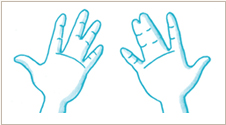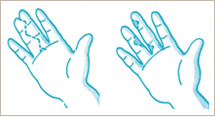Polydactyly & Syndactyly
Polydactyly implies that there is extraordinary supernumerary finger or toe on hand or foot. Thumb is the most common site of involvement when it occurs on the hand. Polydactyly of the thumb varies in types according to the arrangement of bone, tendon, and soft tissue.

Syndactyly is a condition that two or more digits are fused together. The most common site is the 3rd web between the 3rd and 4th finger. It varies from the complete fusion of the bony structure to the fusion of the skin mimicking the web. Polydactyly and syndactyly coexist frequently and complicated cases are not infrequently encountered, either. Although these are common congenital anomalies of the hand and there is some familial tendency, most of the cases have unknown etiologies.
 Simple form of polydactyly and syndactyly can be corrected with singles stage surgery. However, in complicated cases with complex relationships among the bone, joint, and tendon, several times of surgical treatment may be necessary for the near-normal structure and fucntion.
Simple form of polydactyly and syndactyly can be corrected with singles stage surgery. However, in complicated cases with complex relationships among the bone, joint, and tendon, several times of surgical treatment may be necessary for the near-normal structure and fucntion.
Optimal timing of surgery
Most of the polydactyly had better be treated at the age of 1 or 2 because of its complexity of relationship between the bone and joint except the case of simple polydactyly which can be corrected before the 100 days. 1 ~ 2 days of hospitalization is sufficient and general anesthesia is necessary.
Except the extremely simple case, surgery should ensure the preservation of the necessary organ and restoration of the deficient tissue. Ligament and tendon of the extradigit should be safely transferred to the rest of the digit so that the functional recovery can be obtained. In some cases, partial osteotomy and fixation of the joint are necessary for some period. If the extradigit is almost same as the normal digit, combined two digits can be united into the new one digit. In this case, nail is cleaved with growth. Most common complication after the first surgical correction is the bulging due to the regrowth of the bone from the remaining growth plate of the resected extradigit. In this case, osteotomy of the protruded bone is indicated. Zig-zag deformity may also occur. Fingers with polydactyly have tendency of growing obliquely into ‘Y’ shape even after the extradigit is resected. This is the most common complication in case of complicated type of polydactyly. If the deformity is grave, surgical intervention can be considered in the preschool age. If it’s not severe, correction with osteotomy is planned after the age of completion of the bony growth.
Types of syndactyly
Syndactyly is classified by the degree of the fused tissue. That is, if fusion is extended to the tip of the nail, it is called complete type. If the fusion ends at the mid-portion of the finger, it is designated as the incomplete type. If the fusion involves the deep structure like bone, it is called complicated type and if only the superficial skin is fused, it is called simple type. In complicated type of syndactyly, tendon, ligament, joint, nerve and vessels are under the complex relatiohships.
Timing of surgery
Timing of surgery is up to the complexity and the site of fusion. In general, surgery is planned at the age of 1 to 2. However, 1st web and 4th web should be separated before the age of 1 because the short digit may prohibit the normal growth of long digit so that can cause the distortion of the bony structure of the finger. When more than 3 fingers are fused, 2 to 3 staged separations should be planned.
Hospitalization and general anesthesia is inevitable and longer operation and recovery time with longer hospital stay than the cases of polydactyly are needed. Surgery aims to the separation of the fused fingers and the creation of the web space so that the independent function of the finger can be obtained.
 To avoid the postoperative contracture, zig-zag incision and skin graft from the inguinal area should be performed. As color and texture of the grafted skin are different from those of the recipient fingers, contracture along the incisional scar may be brought about even though the first surgery was successful. Several times of secondary surgery are necessary in most of the cases because the narrowing of the web space and distortion of the finger due to the scar contracture are encountered frequently.
To avoid the postoperative contracture, zig-zag incision and skin graft from the inguinal area should be performed. As color and texture of the grafted skin are different from those of the recipient fingers, contracture along the incisional scar may be brought about even though the first surgery was successful. Several times of secondary surgery are necessary in most of the cases because the narrowing of the web space and distortion of the finger due to the scar contracture are encountered frequently.
Postoperative care
Though stitch can be removed in 2 weeks, the splint or the K-wire fixation following the reconstruction of the joint should be maintained for 3 to 4 weeks. General anesthesia may be necessary for the stitch out. Massage and splint are needed for softening the skin graft












